Don't wanna be here? Send us removal request.
Text






1 note
·
View note
Text

#body language#psychology#anatomy#blaze#psychologist#mentalhealth love therapy mentalhealthawareness anxiety motivation psychologist selfcare mindfulness selflove life psicologia
1 note
·
View note
Text

0 notes
Text
What is automatic thinking, and how are schemas an example of that kind of thought?

People are very good at sizing up a new situation quickly and accurately. They figure out who is there, what is happening, and what might happen next. When you attended your first college class, for example, you probably made quick assumptions about who people were (the person standing at the lectern was the professor) and how to behave. We doubt that you confused the class with a fraternity party. And you probably reached these conclusions without even being aware that you were doing so. Imagine a different approach: Every time you encounter a new situation, you stop and think about it slowly and deliberately, like Rodin’s statue The Thinker. When you are introduced to someone new, you have to excuse yourself for 15 minutes while you analyze what you have learned and how much you like the person. Sounds exhausting, doesn’t it? Fortunately, we form impressions of people quickly and effortlessly, without much conscious analysis of what we are doing. We do these things by engaging in an automatic analysis of our environments, based on our past experiences and knowledge of the world. Automatic thinking is thought that is nonconscious, unintentional, involuntary, and effort[1]less. Although different kinds of automatic thinking meet these criteria to varying degrees (Bargh et al., 2012; Hassin, 2013; Jonas, 2013; Moors & De Houwer, 2006), for our purposes we can define automaticity as thinking that satisfies all or most of them.
Automatic Thinking Defnition:
Automatic Thinking Thinking that is nonconscious, unintentional, involuntary, and effortless.
Automatic thinking helps us understand new situations by relating them to our prior experiences. When we meet someone new, we don’t start from scratch to figure out what he or she is like; we categorize the person as “an engineering student” or “like my cousin Helen.” The same goes for places, objects, and situations. When we walk into a fast-food restaurant we’ve never visited, we know, without thinking, not to wait at a table for a waiter and a menu. We know that we have to go to the counter and order, because our past experience automatically tells us that this is what we do in fast-food restaurants. More formally, people use schemas, which are mental structures that organize our knowledge about the social world. These mental structures influence the information we notice, think about, and remember (Bartlett, 1932; Heine, Proulx, & Vohs, 2006; Markus, 1977).
The term schema is very general; it encompasses our knowledge about many things—other people, ourselves, social roles (e.g., what a librarian or an engineer is like), and specific events (e.g., what usually happens when people eat a meal in a restaurant). In each case, our schemas contain our basic knowledge and impressions that we use to organize what we know about the social world and interpret new situations. For example, if you watch the television show The Bachelor or The Bachelorette, you have probably developed schemas for different types of contestants, such as “the snide backstabbing villain” and the “naïve one whose heart will be broken.”
Schemas definition:
Schemas Mental structures people use to organize their knowledge about the social world around themes or subjects and that influence the information people notice, think about, and remember.
Schemas are very useful for helping us organize and make sense of the world and to fill in the gaps of our knowledge. Think for a moment what it would be like to have no schemas at all. What if everything you encountered was inexplicable, confusing, and unlike anything else you’ve ever known? Tragically, this is what happens to people who suffer from a neurological disorder called Korsakov’s syndrome. People with this disorder lose the ability to form new memories and must approach every situation as if they were encountering it for the first time, even if they have actually experienced it many times before. This can be so unsettling—even terrifying—that some people with Korsakov’s syndrome go to great lengths to try to impose meaning on their experiences.
In short, having continuity, being able to relate new experiences to our past schemas, is so important that people who lose this ability invent schemas where none exist. Schemas are particularly useful when we are in confusing situations, because they help us figure out what is going on. Consider a classic study by Harold Kelley (1950) in which students in different sections of a college economics class were told that a guest lecturer would be filling in that day. To create a schema about what the guest lecturer would be like, Kelley told the students that the economics department was interested in how different classes reacted to different instructors and that the students would thus receive a brief biographical note about the instructor before he arrived. The note contained information about the instructor’s age, background, teaching experience, and personality. One version said, “People who know him consider him to be a very warm person, industrious, critical, practical, and determined.” The other version was identical except that the phrase “a very warm person” was replaced with “a rather cold person.” The students received one of these personality descriptions at random. The guest lecturer then conducted a class discussion for 20 minutes, after which the students rated their impressions of him. Given that there was some ambiguity in this situation—after all, the students had seen the instructor for only a brief time— Kelley hypothesized that they would use the schema provided by the biographical note to fill in the blanks. This is exactly what happened. The students who expected the instructor to be warm gave him significantly higher ratings than the students who expected him to be cold, even though all the students had observed the exact same teacher behaving in the same way. The students who expected the instructor to be warm were also more likely to ask him questions and to participate in the class discussion. Has this happened to you? Have your expectations about a professor influenced your impressions of him or her? Did you find, oddly enough, that the professor acted just as you’d expected? Ask a classmate who had a different expectation about the professor what he or she thought. Do the two of you have different perceptions of the instructor based on the different schemas you were using? Of course, people are not totally blind to what is actually out there in the world. Sometimes what we see is relatively unambiguous and we do not need to use our schemas to help us interpret it. For example, in one of the classes in which Kelley conducted his study, the guest instructor was quite self-confident, even a little arrogant. Given that arrogance is a relatively unambiguous trait, the students did not need to rely on their expectations to fill in the blanks. They rated the instructor as arrogant in both the warm and cold conditions. However, when they rated this instructor’s sense of humor, which was less clear-cut, the students relied on their schemas: The students in the warm condition thought he was funnier than the students in the cold condition did. The more ambiguous our information is, then, the more we use schemas to fill in the blanks. It is important to note that there is nothing wrong with what the students in Kelley’s study did. As long as people have reason to believe their schemas are accurate, it is perfectly reasonable to use them to resolve ambiguity. If a stranger comes up to you in a dark alley and says, “Take out your wallet,” your schema about such encounters tells you that the person wants to steal your money, not admire pictures of your family. This schema helps you avert a serious and perhaps deadly misunderstanding.
Which Schemas Do We Use? Accessibility and Priming:
The social world is full of ambiguous information that is open to interpretation. Imagine, for example, that you are riding on a city bus and a man gets on and sits beside you. He mutters incoherently to himself and rocks back and forth in his seat. At one point, he starts singing an old Nirvana tune. How would you make sense of his behavior? You have several schemas you could use. Should you interpret his behavior with your “alcoholic” or “mentally ill person” schema? How will you decide? The schema that comes to mind and guides your impressions of the man can be affected by accessibility, the extent to which schemas and concepts are at the fore[1]front of the mind and are therefore likely to be used when making judgments about the social world (Chaxel, 2014; Higgins, 1996a; Wheeler & DeMarree, 2009; Wyer & Srull, 1989). Something can become accessible for three reasons. First, some schemas are chronically accessible due to past experience (Chen & Andersen, 1999; Coane & Balota, 2009; Schlegel et al., 2009). This means that these schemas are constantly active and ready to use to interpret ambiguous situations. For example, if there is a history of alcoholism in your family, traits describing a person with alcoholism are likely to be chronically accessible to you, increasing the likelihood that you will assume that the man on the bus has had too much to drink. If someone you know has a mental illness, however, thoughts about how people with mental illnesses behave are likely to be more accessible than thoughts about someone with alcoholism, leading you to interpret the man’s behavior very differently.
Second, something can become accessible because it is related to a current goal. The concept of mental illness might not be chronically accessible to you, but if you are studying for a test in your abnormal psychology class and need to learn about different kinds of mental disorders, this concept might be temporarily accessible. As a consequence, you might be more likely to notice the man on the bus and interpret his behavior as a sign of a mental disorder—at least until your test is over and you no longer have the goal of learning about mental illnesses (Eitam & Higgins, 2010; Martin & Tesser, 1996; Masicampo & Ambady, 2014).
Lastly, schemas can become temporarily acces[1]sible because of our recent experiences (Bargh, 1996; Higgins & Bargh, 1987; Oishi, Schimmack, & Colcombe, 2003). This means that a particular schema or trait happens to be primed by something people have been thinking or doing before encountering an event. Suppose that right before the man on the bus sat down, you were reading Girl, Interrupted, Susanna Kaysen’s memoir about her time in a psychiatric hospital. Given that thoughts about psychiatric patients were accessible in your mind, you would probably assume that the man had a mental illness. If, however, you had just looked out the window and seen a man leaning against a building drinking from a paper bag, you would probably assume that the man on the bus was drunk. These are examples of priming, the process by which recent experiences increase the accessibility of a schema, trait, or concept. Reading Girl, Interrupted primes certain traits, such as those describing people with mental illnesses, making it more likely that these traits will be used to interpret a new event, such as the behavior of the man on the bus, even though this new event is completely unrelated to the one that originally primed the traits.
Accessibility:
The extent to which schemas and concepts are at the forefront of people’s minds and are therefore likely to be used when making judgments about the social world
Self-Fulfilling Prophecy:
The case wherein people have an expectation about what another person is like, which influences how they act toward that person, which causes that person to behave consistently with people’s original expectations, making the expectations come true.
Low-Effort Thinking:
People are extremely good at social cognition, which refers to the ways in which people think about themselves and the social world. Although no computer can match us in this kind of thinking, we are not perfect social thinkers. Social psychologists have uncovered some fascinating mistakes to which we are prone, despite our uncanny cognitive abilities. A great deal of social cognition—how people think about themselves and the social world—involves automatic thinking, which is nonconscious, unintentional, involuntary, and effortless.
People as Everyday Theorists:
Automatic Thinking with Schemas An important part of automatic thinking is using our past knowledge to organize and interpret new information. More specifically, people use schemas, mental structures for organizing their knowledge about the social world around themes or subjects and for influencing what they notice, think about, and remember. Schemas are extremely useful tools for reducing ambiguity about the social world.
Which Schemas Do We Use?:
Accessibility and Priming Sometimes a situation is ambiguous and it is not clear what schema applies. Schemas are most likely to be used if they are high in accessibility, which means they are at the forefront of our minds. Schemas can be accessible because we have used them a lot in the past, because they are related to our current goals, or because of priming, which is the process by which recent experiences increase the accessibility of a schema.
What are other types of automatic thinking and how do they operate?
• Types of Automatic Thinking There are several other forms of automatic thinking that help us interpret the social world and make decisions, without necessarily intending to do so.
• Automatic Goal Pursuit In our everyday lives there are often competing goals, and the one we choose to follow can happen automatically. People often act on goals that have been recently primed.
• Automatic Decision Making People’s unconscious minds often help them make good decisions. A good procedure is to analyze all the alternatives, spend some time analyzing the options consciously, and then distract oneself to allow unconscious processes to operate.
• Automatic Thinking and Metaphors About the Body and the Mind In addition to using schemas to reduce ambiguity about the world, people use metaphors about the mind and the body. Physical sensations (e.g., holding a heavy clipboard) can prime a metaphor (e.g., that important thoughts “have weight”), which then influences people’s judgments (e.g., that student opinion should be given more weight on a campus issue).
• Mental Strategies and Shortcuts: Judgmental Heuristics Another form of automatic thinking is the use of judgmental heuristics, which are mental shortcuts people use to make judgments quickly and efficiently. Examples are the availability heuristic, whereby people base a judgment on the ease with which they can bring something to mind, and the representativeness heuristic, whereby people classify something according to how similar it is to a typical case. Heuristics are extremely useful and often produce accurate judgments, but can be misused, producing faulty judgments.
Social Psychology Ninth Edition ;Elliot Aronson, Timothy D. Wilson, Robin M. Akert, Samuel R. Sommers
https://learn-psychology.com/automatic-thinking/
1 note
·
View note
Photo
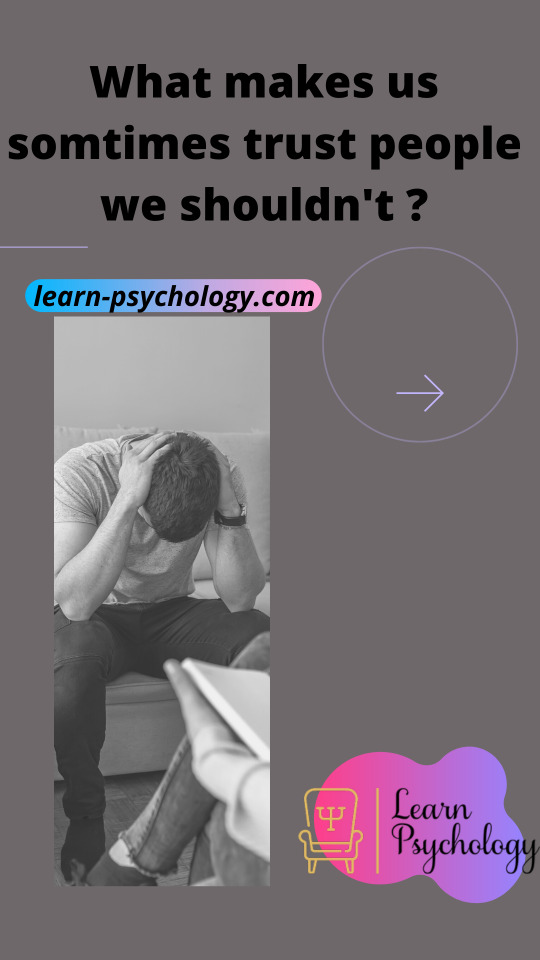

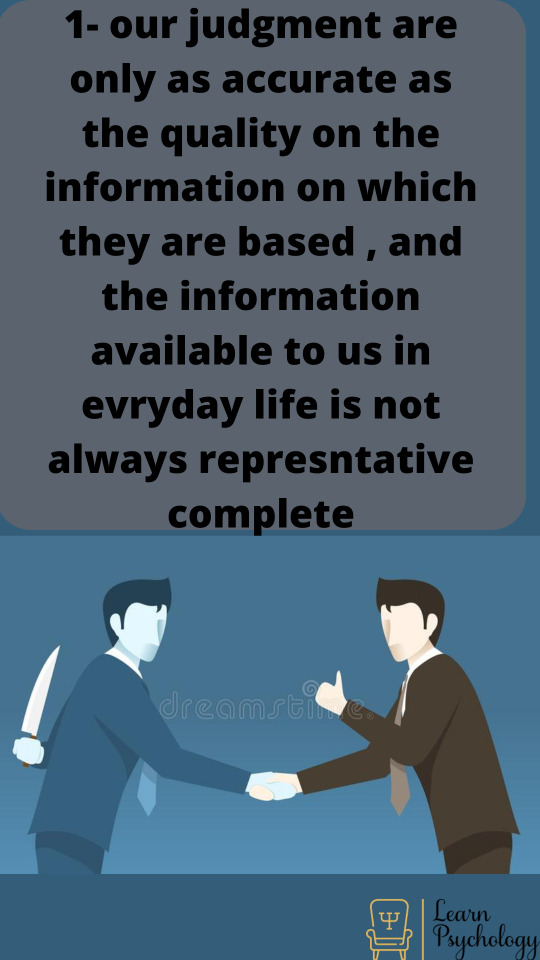
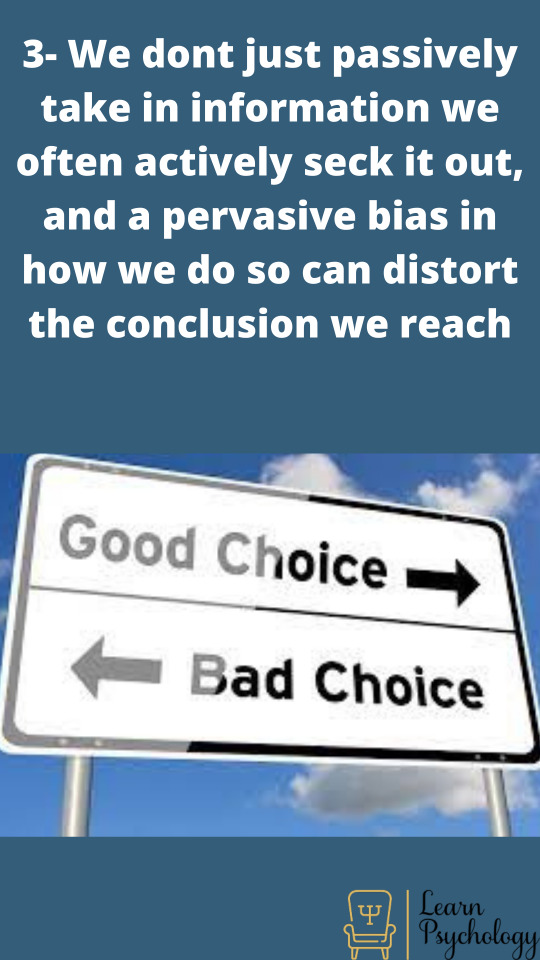
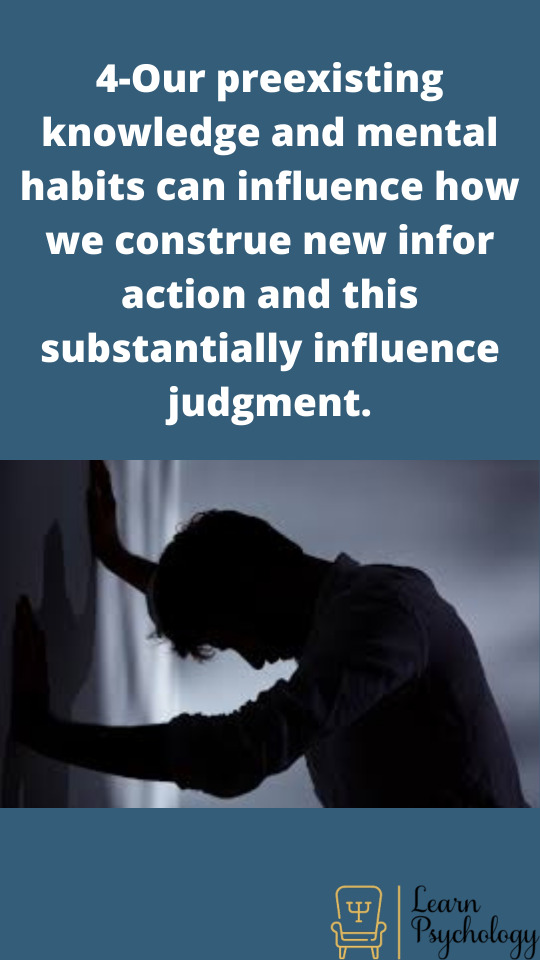


what makes us sometimes trust people we shouldn't
https://learn-psychology.com/what-make-us-somtimes-trust-people-we-shouldnt/
1 note
·
View note
Text
0 notes
Text
the defintion of personality:

https://learn-psychology.com/blog/
G. Allport : in a book byreference dating from 1937, had the personality represents the dynamic organization of psychological systems which determine the characteristic behaviors of an individual and his thoughts.
H.J. Eysenck 1950 : it was more about the organization more or less firm and lasting “of character, temperament, intelligence and physique “of a person who determines its adaptation to the environment.
P. Pichot 1965 : personality is “the dynamic integration of the aspects cognitive, conative (that is to say instinctual and volitional) and affective as well as the psychological and morphological of an individual “. In other words, it covers all the provisions which help to determine the behaviors that differ from one person to another.
These last two definitions have the advantage of listing the main components that come into play in the psychological functioning of an individual and to mention the stability of the whole of which depends on the adaptation to the environment.
cognitive theories of personality :
the cognitive psychology paradigm has concerned the domain of personality from the 1950. The prototype of such a model can be found in the work of G.A. Kelly [16]. This model says “personal constructs” designates the constructs hypotheses formed by the subject on the psychic and social objects of the environment. The technique The study favored by this work is that of repertory grids which allow an analysis of the representations of oneself and of others. It leads to the description of “cognitive styles”.
– A. Beck, A. Ellis and J. Young : They focused on on models that characterize a person’s need for new information (searching for sensations, sensitivity or insensitivity to the perceptual domain, preference complexity, etc.). self models memorized cognitive structures, representations of events or objects, generalizations and theories of previous experiences. Believes faulty and inappropriate thinking patterns, and Cognitive distortions are likely to appear The main source of perseverance Different types of personality disorders that can be Undergoing cognitive psychotherapy.
Psychodynamic theories :
they are based on the theory of instincts who drives, of biological origin, are the forces which push the individual to exert a preformed activity in the nervous structures. The story of development is that of the struggle between the person’s instinctual pole and numerous sources of tension. Acquisitions represented by satisfactions experiences, frustrations and conflicts, are all lived experiences that the individual assimilates gradually during its evolution. Dynamic psychology developed by S. Freud is based on the development of affectivity and on the concepts of impulses, desires, obstacles and Conflicts. The genesis of the personality is the history of the development of the primary impulses. The individual is a a place where different, often contradictory, forces are exerted. Their result represents the state of equilibrium from subject. The drives create a state of tension, source of discontent. To the principle of pleasure that governs driving forces oppose the test of reality.
social and cultural theories :
If the Freudian conception makes society a solution that men bring to problems fundamentally individual, many authors came in the course of the 20 century to reverse this relationship between the individual and society. Ethnology has allowed an original approach to these influences on the development of the personality, in large part thanks to American works of cultural anthropology illustrated by the names of M. Mead, R. Benedict or R. Linton. These authors have shown to what extent notions like those of masculinity-femininity, relationships. family, of the hierarchy of values concerning money, power, work, clinical manifestations of anxiety or aggression could be culturally determined.
We gave the name culturalism to these options theory that favors social factors and cultural aspects in personality development to which the names of H. Sullivan are attached, E. Fromm, as well as those of certain psychoanalysts dissidents like W. Reich or A. Adler.
Trait theory :
The description of the personality in terms of traits, “What distinguishes and characterizes a person” according to Littré, assumes that the reactions of an individual to a given stimulus are sufficiently stable in the time, relatively independent of the situations particulars encountered and that we can classify the subjects based on responses to stimuli.
-For G. Allport, it is a “neuro-psychic structure with the capacity to make many functionally equivalent stimuli, to trigger and to guide equivalent forms of adaptive and expressive behavior ”
-For A. Caspi, all the traits show individual differences in behavior, thoughts or feelings in a relatively consistent and stable. Develop a systematic inventory of the ways in which individuals differ from one another others designates a nomothetic approach to personality, centered on sets of individuals in which we will describe the stable characteristics of their behaviour. Quite different is the idiosyncratic approach to personality, centered on a person unique for which it is impossible to describe all individuals using the same traits. The nomothetic approach has prevailed and it dominates clinical research on personality even though the exclusive approach to inter-individual disparities allows more to explore what separates individuals than the individuals themselves.
The humanistic theory :
the humanistic theory to personality is represented here by the works of abraham maslow and carl rogers . their theories emphasize human strengths and aspiration, conscios free will, and the fulfillment of human potential. They present a flattering and optimistic image of human nature and describe us as active, creative beings concerned with growth and self-actualization.
LES PERSONNA L ITÉS PATHO L OGIQUES, J.D.guelfi Patrick Hardy médecine sciences publication. lavoisier
Theories of Personality: Duane P. Schulz, Sydney E. Schulz, Cengage learning 11°edition
https://learn-psychology.com/definition-of-personality/
#psychology#psychologist#psycholonials#psychopath#personality#mental health#mental disorder#psyblog#new blog#blogger
1 note
·
View note
Text
THE NOTION OF NORMALITY AND PATHOLOGY

the notion of normality :
The use of the notion of “normality” certainly presents undeniable dangers in the hands of those who hold medical, political, social, cultural, economic, philosophical, moral, legal or aesthetic and, why not, intellectual authority ? The story ancient or contemporary of communities, as well as ideologies, great or small, serves us as cruel examples of this, each one only keeping in memory very selective representations, depending on your personal choices.If “normality” refers to a majority percentage of behaviors or viewpoints, bad luck for those who are in the minority. If, on the other hand, the normality” assumes the function of a collective ideal, much is known about the risks rushed, even by the majority, as long as they are reduced to silence forthose who believe in or ascribe to themselves the vocation of defending the said ideal by force;they intend to limit the affective development of others after they have also seen themselves aeidenlally blocked and then elaborate secondarily subtle defensive justifications.In fact, “normality” is more commonly seen in relation to others, to the ideal or rule. Seeking to remain or become “normal”, the child identifies with the “big ones” and the anxious imitate them. In both cases, the question is manifests: “How do others do?” and it is implied: “How do the great ones do?”
jean bergeret try to give a definition for the normal personality :
(Really ‘sane’ isn’t just a self-proclaimed person, norabove all, a sick person disregards himself, but is a subject who retains within himself as many conflicting fixations as so many other people, who have not encountered internal or external difficulties in his way that are superior to his genetic or acquired equipment, defensive or adaptive personal faculties, and what if Let the game flexible enough for their instinctive needs, their own Primary and secondary processes at the personal and social levels, taking into account A fair account of reality and the right to act in an apparently skewed manner in exceptional “abnormal” circumstances.)
It will therefore be necessary to insist on the independence of the notion of “normality” in relation to the notion of structure. It has, in fact, been amply demonstrated by everyday observation that a personality reputed to be “normal” can, at any moment of its existence, enter into mental pathology, including psychosis, and that, conversely, a mental patient, even psychotic, well and precociously treated, retains all the chances of returning to a situation of “normality”, in a too simplistic way, the “normal” people to the “mentally ill”, when considering the deep structure. no more we allow ourselves to be deceived by external manifestations, however noisy, corresponding to the state (momentary or prolonged) in which a real structure is found, and not to a real change of that structure itself. In order, at least initially, stable structures (that is, psychotic or neurotic), it seems evident that there are so many readings in passing, within a line psychotic structural lineage, between “psychosis” and a certain form of “normality” adapted to the structuring of a psychotic type, and within a neurotic structural lineage, between “neuroses” and a certain form of adapted “normality” to structuring of the neurotic type.
PATHOLOGY AND NORMALITY :
G. Canguilhem (1966) refers to several works from past years: A. Comte (1842), which is based on Broussais’s principle, presents the disease as excess or lack in relation to the “normal” state; C. Bernard (1865), for whom every illness is more than the disturbed expression of a “normal” function; Leriche (1953), for who there is no predictable threshold between the physiological and the pathological, and health can be summarized as a state of silence of the organs; Jackson, finally, for whom the illness is constituted by an ordeal and a rearrangement, linked to a dissolution and regression, ideas taken up by H. Ey when specifying the order of dissolution, in the disease, of mental functions, initially from what was recently acquired in ontogenetic maturation of the subject. G. Canguilhem defines the disease as a reduction in margin of tolerance in relation to the infidelities of the environment. “Normality” would also be synonymous with adaptation, and this idea contains nuances that allowed G.Canguilhem consider as remaining within the limits of “normal” certain states considered by others as pathological, insofar as these states can express a relationship of “normality” with the subject’s private life.
M. Klein (1952) proposes, in every psychogenetic evolution of the child, a primitive persecutory position, followed by a more or less oedipal depressive position. The first position, above all, would necessarily proceed through economic mechanisms of the psychotic type, and any further pathology could only have in account archaic fixations to these phases obligatory on all. Although it is opportune to no longer consider the “normal” structure as having followed an infantile evolution of privileged slime, in the same way it is difficult to consider, in the case of neurotics or from borderline states, that all the individual has known a period in which the his ego would have initially been constituted in a psychotic mode, in the very precise sense that we will continue to use this term, that is, in an economy of authentic fragmentation, true structural organization and not just stage, gap or evolutionary imperfection.
Freud (1968) believed that he could determine the natural state in the child from the way in which, little by little, the positional and dynamic aspects of personality and the way in which instinctive conflicts are engaged and resolved are created.
G. Jung (1913) sought to present the complementary faces of the mythical characters Prometheus (the one who thinks before) and Epimetheus (the one who thinks after), that is, introverted and extroverted, referring to the works of Carl Spilteler and by W. Goethe. “Normality” would be linked to the union of these two attitudes, which C.G Jung compares it to the Brahmanical conception of the symbol of union. On the other hand, the author compares the notions of adaptation (submitting oneself to the environment), insertion (linked solely to the notion of environment) and “normality”, which would correspond to a frictionless insertion, intended simply to fulfill objectively fixed conditions. The pathology would arise as soon as the individual leaves the context of submission to the environment, corresponding to the “insertion” reserved solely for this circle. This seems to us to be closer to what I will describe later, regarding the limit state analytic depression movement, as long as it risks leaving the circle, embarrassing but reassuring, of the phallic family member.
Jean bergeret : that it is worth distinguishing, on the one hand, authentic, solid, fixed and definitive (psychotic or neurotic) and, on the other hand, the intermediate organizations (borderline states), less specified in a durable way and which may give rise to more stable arrangements (characteristic diseases or perversions). With regard to the first group, we can consider that there are so many terms of passage between “normality” and decompensated psychosis, within the fixed psychotic structural gem line, as between “normality” and decompensated neurosis, within the fixed neurotic structural lineage. On the other hand, with regard to the second group, defined as intermediate, we will immediately see that it is not easy consider a real “normality”, due to the huge and permanent antidepressant energy counter-investments put into play (due to precariousness precisely from the adaptation to internal and external realities) and to instability, in the end of accounts, of such organizations not really structured in the definitive sense and full term.
The notion of “normality” would thus be reserved to a state of adequacy happy functional, only within a fixed structure, be it neurotic or psychotic, and the pathological would correspond to a disruption of the balance within the same structural lineage.
jean Bergeret la personnalité normale et pathologique ,3 édition , Dunod
https://learn-psychology.com/the-notion-of-normality-and-pathology/
0 notes
Text
5 fields of psychology

5 fields of psychology
1- clinical psychology
2- social psychology
3- education psychology
4- developmental psychology
5- sport psychology
3 notes
·
View notes
Text
In this blog you will know about psychology and its fields and branches.

Link in the bio🔗
1 note
·
View note
Text
Aaron Beck

Aaron Beck the father and the founder of cognitive behavioral science and CBT therapies was brief and effective.
#psychology#american psycho#psychothérapie#psychiatry#psychologist#CBT#therapy#cognitive#poster#adobe#illustration#quotes
1 note
·
View note
Text

1 note
·
View note
Text
Sometimes the only way to fix problems and obstacles is the hard way.

1 note
·
View note
Text

https://learn-psychology.com
The love of reading books
1 note
·
View note
Text
https://learn-psychology.com

3 notes
·
View notes
Text
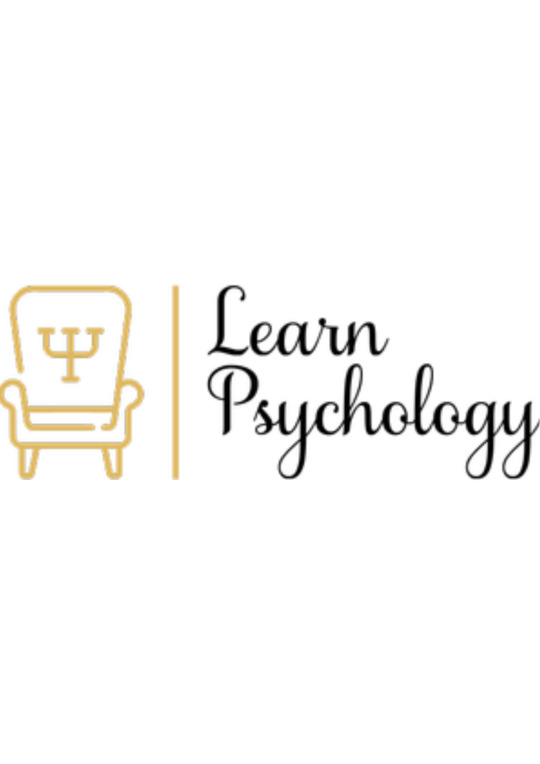
2 notes
·
View notes